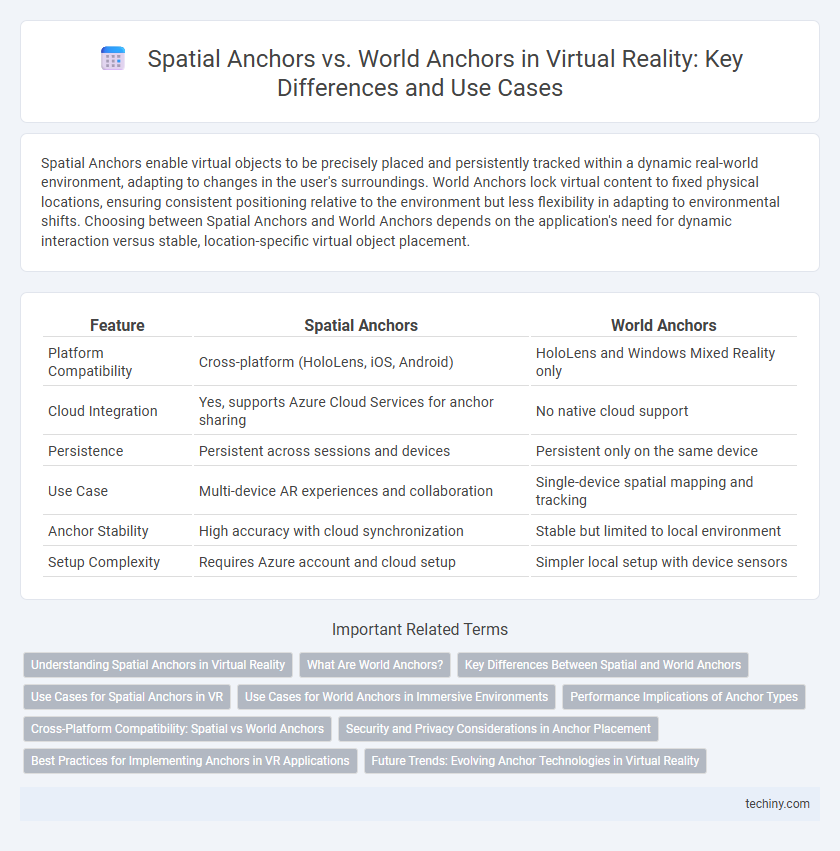Spatial Anchors enable virtual objects to be precisely placed and persistently tracked within a dynamic real-world environment, adapting to changes in the user's surroundings. World Anchors lock virtual content to fixed physical locations, ensuring consistent positioning relative to the environment but less flexibility in adapting to environmental shifts. Choosing between Spatial Anchors and World Anchors depends on the application's need for dynamic interaction versus stable, location-specific virtual object placement.
Table of Comparison
| Feature | Spatial Anchors | World Anchors |
|---|---|---|
| Platform Compatibility | Cross-platform (HoloLens, iOS, Android) | HoloLens and Windows Mixed Reality only |
| Cloud Integration | Yes, supports Azure Cloud Services for anchor sharing | No native cloud support |
| Persistence | Persistent across sessions and devices | Persistent only on the same device |
| Use Case | Multi-device AR experiences and collaboration | Single-device spatial mapping and tracking |
| Anchor Stability | High accuracy with cloud synchronization | Stable but limited to local environment |
| Setup Complexity | Requires Azure account and cloud setup | Simpler local setup with device sensors |
Understanding Spatial Anchors in Virtual Reality
Spatial Anchors in Virtual Reality allow precise placement of digital content in a real-world environment by using advanced algorithms to track spatial coordinates, enhancing user interaction and immersion. Unlike World Anchors, which depend on the physical environment's static features, Spatial Anchors offer greater flexibility by dynamically adapting to changes in the surroundings. This technology improves persistent AR experiences by maintaining consistent positioning of virtual objects across sessions and devices.
What Are World Anchors?
World Anchors are spatial mapping technologies that fix digital content to specific physical locations in a mixed reality environment, ensuring consistent placement across sessions. They use the natural features of the physical world to maintain the position and orientation of virtual objects. Unlike Spatial Anchors, World Anchors are primarily tied to device-local tracking systems and are often used in platforms like Microsoft HoloLens for persistent holographic experiences.
Key Differences Between Spatial and World Anchors
Spatial Anchors use cloud-based technology to enable shared and persistent positioning of virtual objects across multiple devices and sessions, making them ideal for collaborative AR and VR experiences. World Anchors rely on device-local environment mapping to lock virtual content to a physical location without internet dependency, ensuring stability in single-device applications. Key differences include Spatial Anchors' cross-platform persistence and real-time synchronization versus World Anchors' offline functionality and device-specific spatial mapping.
Use Cases for Spatial Anchors in VR
Spatial Anchors in Virtual Reality enable precise placement and persistent tracking of virtual objects across multiple sessions and devices, enhancing collaborative experiences and location-based applications. Use cases include multi-user training simulations where consistent object positioning is critical, augmented navigation in indoor environments, and immersive gaming scenarios that blend physical spaces with virtual content. Their ability to anchor content to real-world coordinates supports seamless interaction in shared or evolving environments.
Use Cases for World Anchors in Immersive Environments
World Anchors enable precise and persistent positioning of virtual objects in immersive environments, ensuring stability across sessions for applications like architectural visualization and training simulations. They support large-scale outdoor AR experiences by maintaining alignment with the real world, critical for navigation and location-based services. Their ability to lock holograms to physical locations makes them ideal for collaborative projects where multiple users interact with the same virtual content simultaneously.
Performance Implications of Anchor Types
Spatial Anchors provide enhanced scalability and dynamic environment adaptability by leveraging cloud-based localization, resulting in lower latency and improved synchronization across devices. World Anchors rely on local device mapping, which can lead to increased computational overhead and reduced performance in large or complex environments. Choosing Spatial Anchors optimizes rendering efficiency and tracking accuracy, crucial for high-performance VR applications requiring persistent shared experiences.
Cross-Platform Compatibility: Spatial vs World Anchors
Spatial Anchors enable cross-platform compatibility by allowing persistent virtual object placement across different devices and operating systems, supporting ARKit, ARCore, and HoloLens ecosystems. World Anchors, primarily used in Microsoft HoloLens, offer robust spatial mapping and persistence but are limited to Windows Mixed Reality platforms. Choosing Spatial Anchors ensures seamless multi-device experiences, essential for scalable cross-platform virtual reality applications.
Security and Privacy Considerations in Anchor Placement
Spatial Anchors leverage cloud-based storage, raising concerns about data interception and unauthorized access during transmission and synchronization. World Anchors, stored locally on device hardware, offer enhanced security by minimizing exposure to external threats but risk data loss if the device is compromised. Careful anchor placement must balance privacy by avoiding sensitive environments and security through encrypted data management to protect user spatial mapping information.
Best Practices for Implementing Anchors in VR Applications
Spatial Anchors offer dynamic tracking and cross-device persistence, making them ideal for collaborative VR experiences that require consistent alignment across multiple sessions. World Anchors provide robust, platform-specific positioning, best suited for static environments where precise object placement is crucial. Implementing anchors effectively involves choosing the appropriate anchor type based on application needs and leveraging cloud synchronization for maintaining spatial consistency in complex VR scenes.
Future Trends: Evolving Anchor Technologies in Virtual Reality
Spatial Anchors leverage cloud-based computing to enable persistent virtual object placement across multiple devices, promising scalable and collaborative VR experiences. World Anchors, primarily device-specific and localized, face limitations in adaptability but continue evolving through integration with advanced spatial mapping and AI for improved environmental understanding. Future trends indicate a convergence toward hybrid anchoring systems combining cloud persistence with real-time local adjustments, enhancing accuracy and seamless interaction in expansive virtual environments.
Spatial Anchors vs World Anchors Infographic

 techiny.com
techiny.com